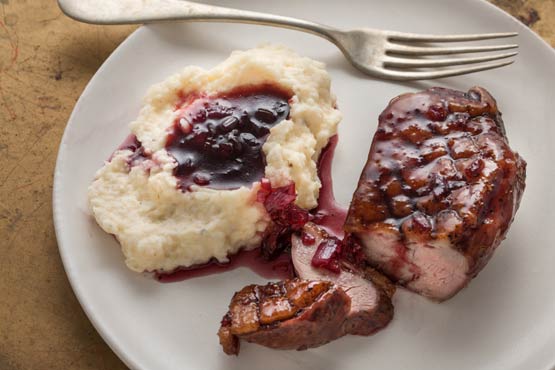 Photo by: Goran Kosanovic --- For The Washington Post
Photo by: Goran Kosanovic --- For The Washington Post
What I like about duck breast - the faint liver-y flavor of the meat graced with well-seasoned and crisped skin - is paired here with a quick pan sauce built upon a dark-fruit jam. The "lacquered" part of the original recipe called for the duck breast to be brushed with the sauce and returned to the oven for a bit, but in the interest of not overcooking the breast meat, we're content to do the kind of rapid-fire pan basting you see chefs do on television.
Speaking of temperature, we're starting the meat in a cold pan instead of placing it on a preheated surface, to get the fat rendering process going.
Fresh duck breasts in smaller weights are more widely available in supermarkets these days, so that's why the recipe calls for either 1 large breast or 2 smaller ones. Even if you use the small ones, you'll still be able to strain and reserve some rendered duck fat for other recipes.
You'll need an instant-read thermometer.
Serve with celery root (celeriac) puree.
![]()
BLACK CURRANT-LACQUERED DUCK BREAST
SERVINGS: 2 to 3
Ingredients
• 2 small duck breasts (about 13 ounces total; may substitute 1 large duck breast; see headnote)
• Kosher salt
• Freshly ground black pepper
• 1 medium shallot
• One 2-inch piece fresh ginger root
• 1 tablespoon honey
• 1/3 cup black currant jam
• 3 tablespoons apple cider vinegar
Steps
Preheat the oven to 375 degrees.
Use a sharp knife to score the fat side of each duck breast in a crosshatch pattern. Season the breasts well with salt and pepper all over, then place in an ovenproof medium skillet or saute pan, skin side down. Place the pan over medium heat; cook for about 8 minutes or until much of the fat has rendered and the skin is crisped and browned. If the sizzle of rendered fat becomes too vigorous (as in, fat jumping out of the pan), reduce the heat to medium-low. Pour off the fat into a heatproof container; strain and reserve.
Turn over the duck breasts; transfer the pan to the oven; cook for 2 to 4 minutes or just until the flesh registers 145 degrees on an instant-read thermometer. (The meat will cook further once it's in the sauce.)
While the breasts are cooking, mince the shallot (to yield 3 tablespoons). Peel and grate the ginger (to yield 1 tablespoon).
Transfer the duck breasts to a plate to rest while you make the sauce.
Return the pan to the stove top over medium heat. Add 2 tablespoons of the strained, rendered duck fat (reserve the rest for another use). Stir in the shallot; cook for about 2 minutes, stirring, then add the ginger, honey, black currant jam and vinegar. Cook for about 3 minutes, stirring a few times, until the mixture has reduced to a bubbling, syrupy consistency. Season lightly with salt and pepper.
Return the duck breasts to the pan, skin side down, over medium-low heat. Brush some of the sauce on each duck breast to coat evenly. Turn the breasts skin side up; rapidly and constantly spoon the sauce over the duck breasts for about 30 seconds, then remove from the heat.
Let the lacquered duck breasts rest for 5 minutes or so (in the pan) before serving or slicing. Drizzle them with the remaining sauce once they're on the plate.
Ingredients are too variable for a meaningful analysis.



 Contact The Editor
Contact The Editor
 Articles By This Author
Articles By This Author